PLEASE
BE PATIENT WHILE IMAGES LOAD
British Sector
In this sector are located the greatest number
of tourist attractions—monuments, palaces, parks, museums,
theaters, concert halls, exhibition centers, international
restaurants, shopping complexes—all flanking Berlin's grand
East-West Axis boulevard.
|
|
| Tiergarten |
Siegessäule
►
East-West Axis:
Straße des 17.Juni
|
Victory Column is located in Tiergarten, an
expansive park near the center of Berlin. The "Victory Goddess"
at the top is an 8-meter high gold-plated bronze casting by
Drake. Just beneath the figure is an open observation
platform, from which one can see for several kilometers in any
direction—Brandenburg Gate to the east, the Hansa Quarter in the
northwest, and the Kaiser Wilhelm Church and Europa Center to
the south.
Victory Column stands in the Strasse des 17.
Juni (17th of June Street), which bisects Tiergarten. The street
name honors East German citizens killed during Soviet military
intervention against a popular protest in June 1953.
|
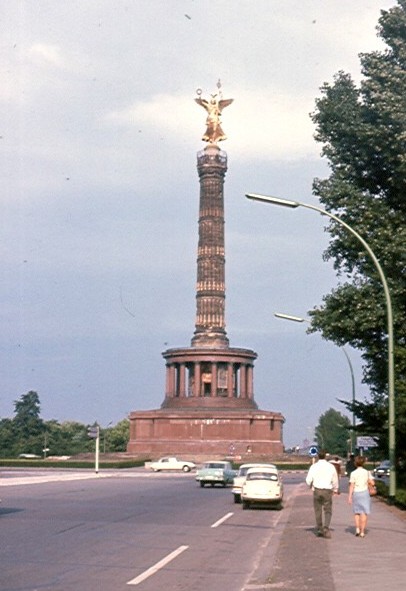 |
|
|
|
|
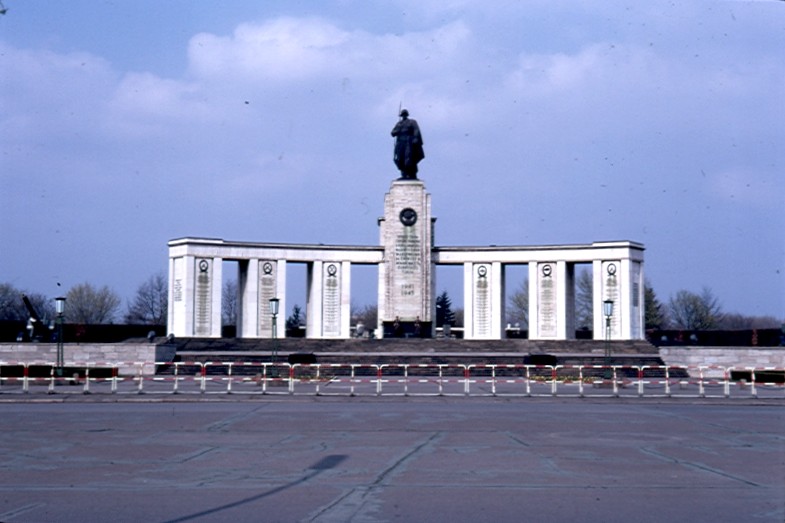 |
◄
Sowjet-Ehrenmal
The Soviet World War II Memorial stands just
west of Brandenburg Gate, and is flanked by the first two Soviet
tanks to enter the German capital in the final assault.
Two armed Russian guards are bussed in from the Soviet Sector
for each shift.
|
|
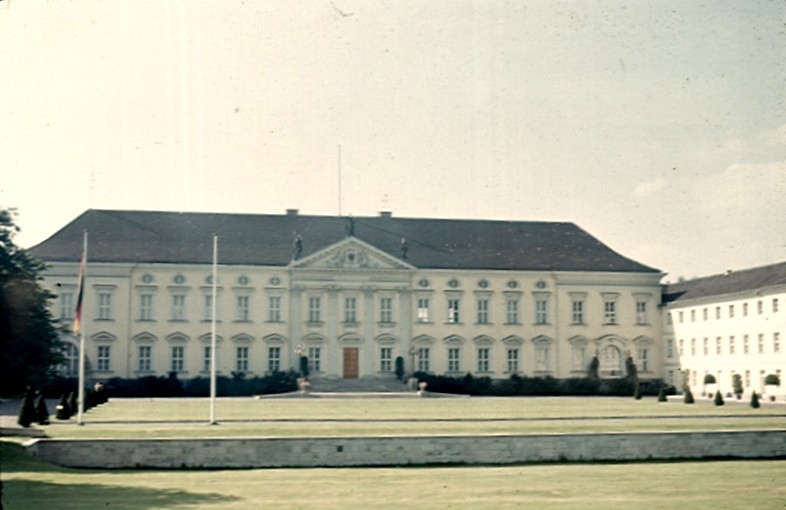 |
◄
Schloss Bellevue
Bellevue Palace is the residence of the
Chancellor of the Federal Republic when he visits Berlin.
|
|
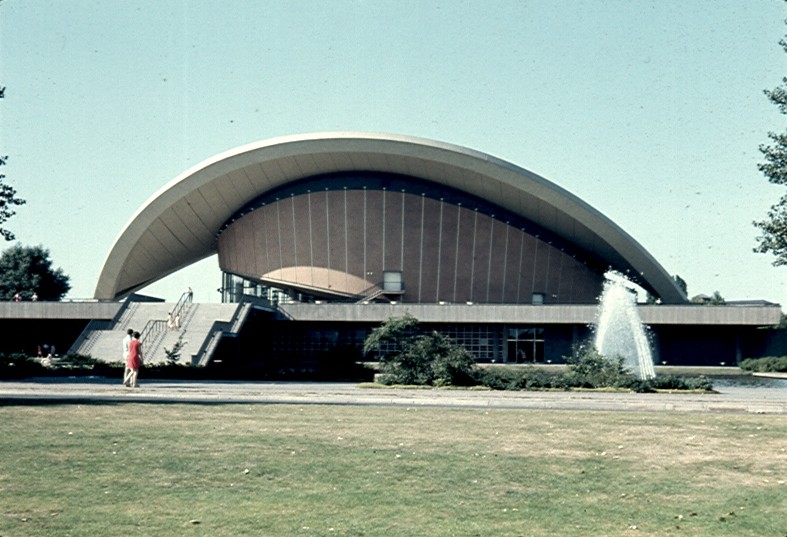 |
◄
Kongresshalle
Architectural examples strewn through
Tiergarten are a mix of traditional and avant-garde. This
public auditorium, nicknamed "Betonauster" (Concrete Oyster),
with its sweeping reverse-curve roof, is clearly on the cutting
edge for its period. (Its daring saddle form collapsed not
long after the author left Berlin.)
|
|
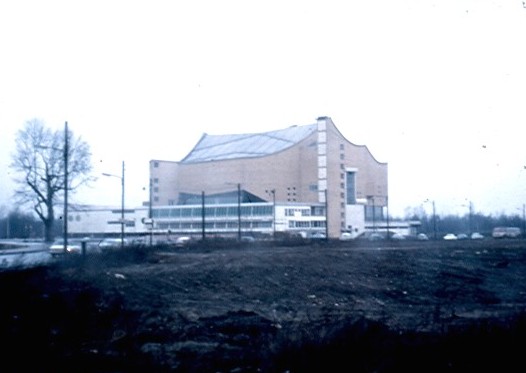 |
◄
Philharmonie
Home of several musical ensembles, including
the Berlin Philharmonic, the orchestra hall is unusual inside
and out. The performance stage is situated low and in the center,
surrounded by the audience. This interior scheme, and the
external appearance of a tent, inspired the building's whimsical
nickname "Circus Karajani," alluding to music director Herbert
von Karajan.
|
|
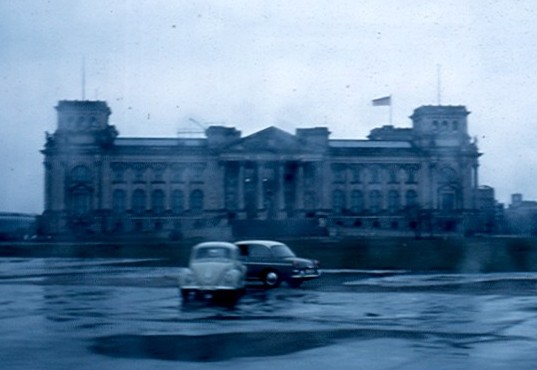 |
◄
Reichstagsgebäude
Gutted by fire in 1933, the German Parliament
building is here under reconstruction. The inscription
over the main entrance reads, "DEM DEUTSCHEN VOLKE" (To the
German People). The Reichstag building stands in the
eastern part of Tiergarten adjacent to the Wall.
|
|
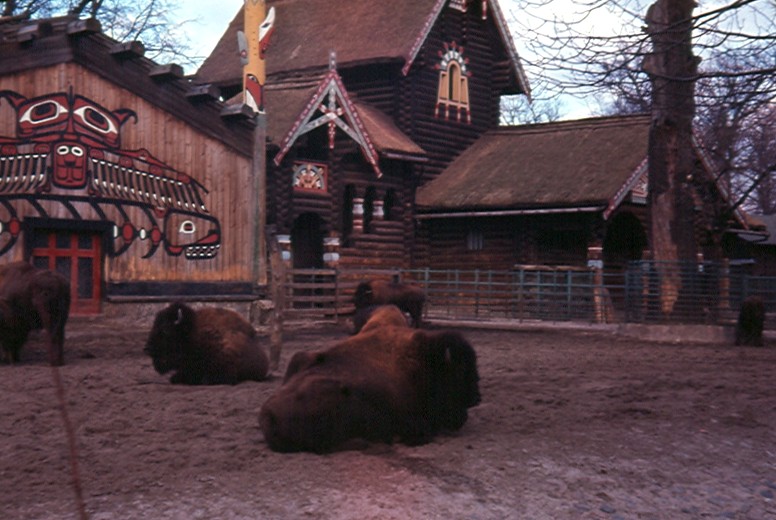 |
◄
Zoologischer Garten
Following modern practice, the Berlin Zoo attempts to display
animals in something approximating their natural habitat. In the case of these American bison, however,
the policy seems to have crossed the line into caricature.
|
|
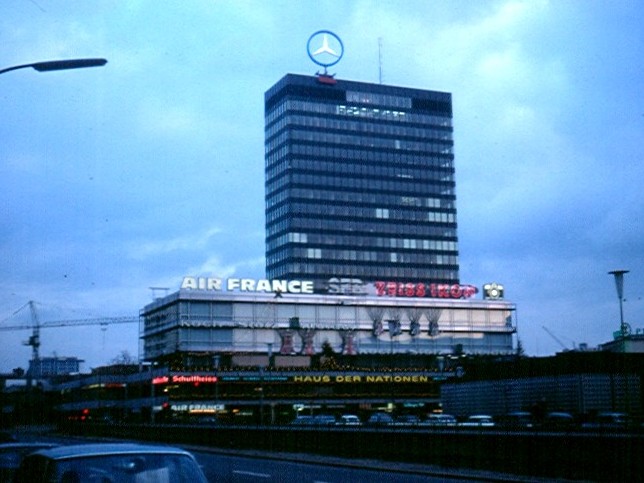 |
◄
Europa Zentrum
Where but in Berlin might one find a shopping
mall—centered around an ice rink—in the middle of downtown?
And did we forget to mention the additional shops in tunnels
underneath the street?
|
Kaiser Wilhelm Gedächtniskirche
►
Only a few steps beyond Kurfürstendamm's
dazzle, the war-shattered shell of the old Kaiser Wilhelm
Memorial Church solemnly broods in twilight silhouette beside
its waffle-sided resurrection.
Kurfürstendamm
▼
As daylight fades, the Ku-Damm flares!
Viewed from the Europa Zentrum, Kurfürstendamm is a triumphant
vision of capitalist prosperity in the grim heart of the
communist bloc. Glowing a mysterious blue in the
foreground is the new tower of the Kaiser Wilhelm Church.
|
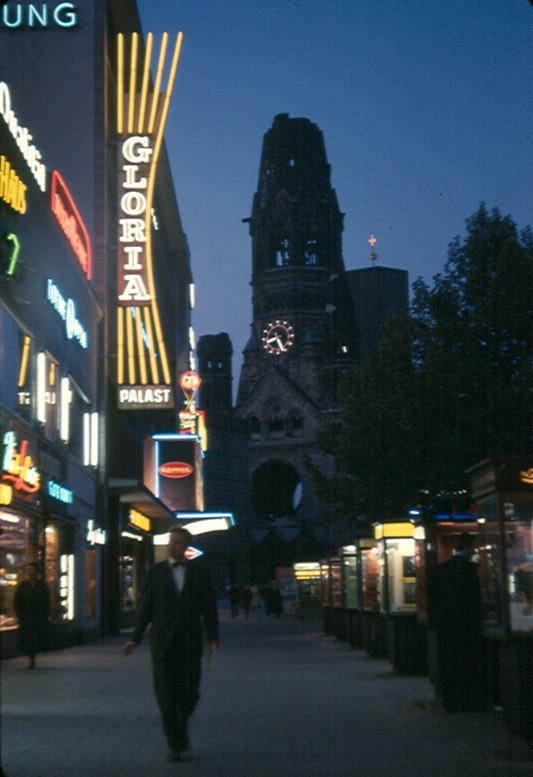 |
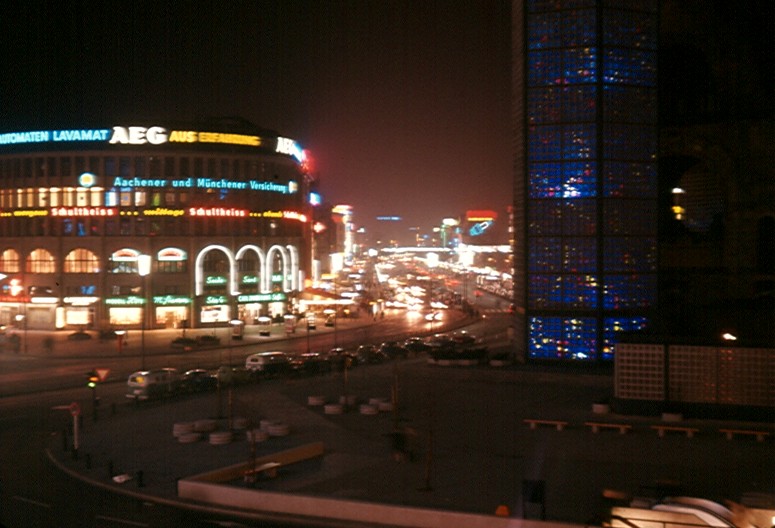 |
|
|
Charlottenburg |
Ernst Reuter Platz
►
East-West Axis:
Straße des 17.Juni - Bismarckstraße
|
The Telefunken building creates a monolith of
light behind the fountains of Ernst Reuter Platz.
Reflections glance off the author's Mercedes, parked in the
foreground.
Ernst Reuter served as Mayor of West Berlin
beginning in 1948.
|
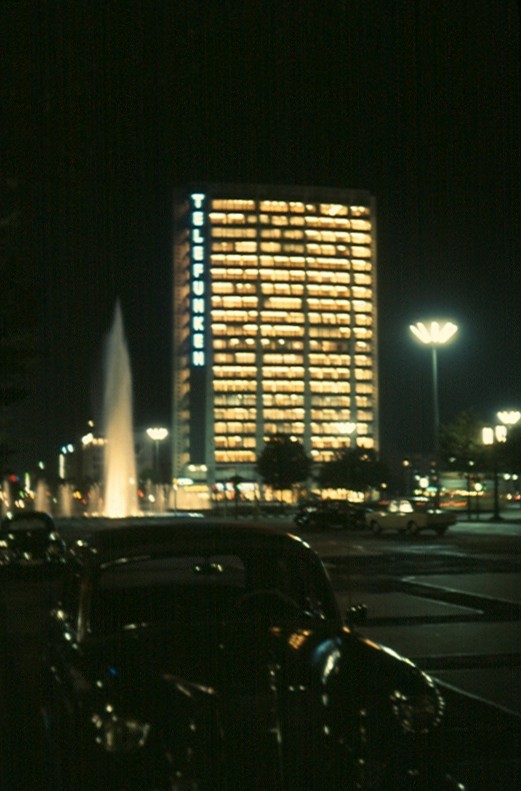 |
|
|
|
|
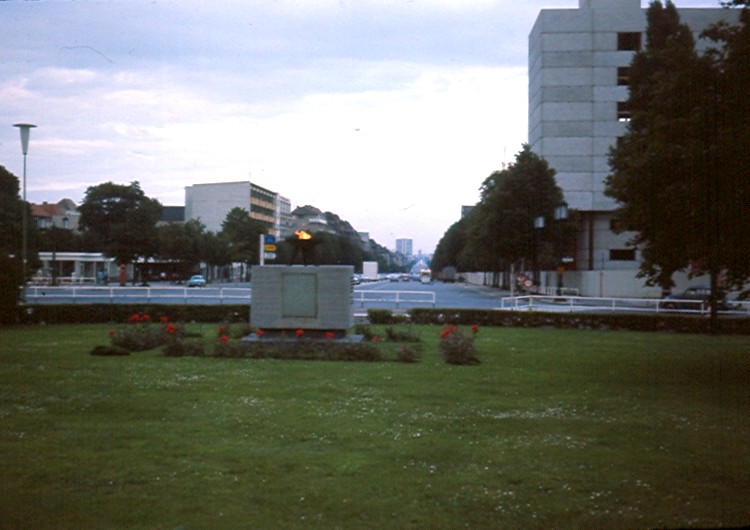 |
◄
Theodor Heuss Platz
East-West Axis:
Kaiserdamm - Heerstraße
|
As the Cold War continues its glacial pace,
this unassuming but steadfast little flame bespeaks hope for the
eventual reunification of Germany. Had anyone at this time
dared prophesy that it would happen in only twenty more years,
he would have been dismissed as a dreamer.
Theodor Heuss was President of the Parliament
of the German Federal Republic from 1949 until 1959.
|
|
|
|
|
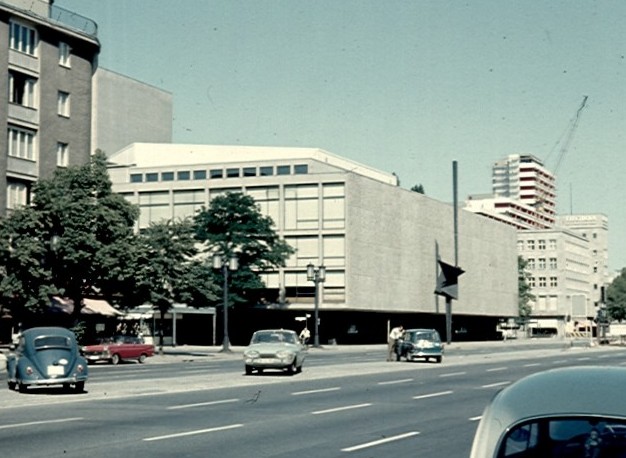 |
◄
Deutsche Oper
In contrast to the many splendorous
performances on the inside, the heavily levitating exterior of
the German Opera is the epitome of plainness, set off only by
its daring black metal sculpture, nicknamed "Schaulich
am Stift" (Ugly on a Stick) by passers-by.
|
Funkturm
►
Scaled down and styled along the lines of
Paris's Eiffel Tower, Berlin's Funkturm features an observation
deck and a restaurant. It is located adjacent to the
Deutschlandhalle exhibition complex, and features a bowl-shaped
garden to the rear.
|
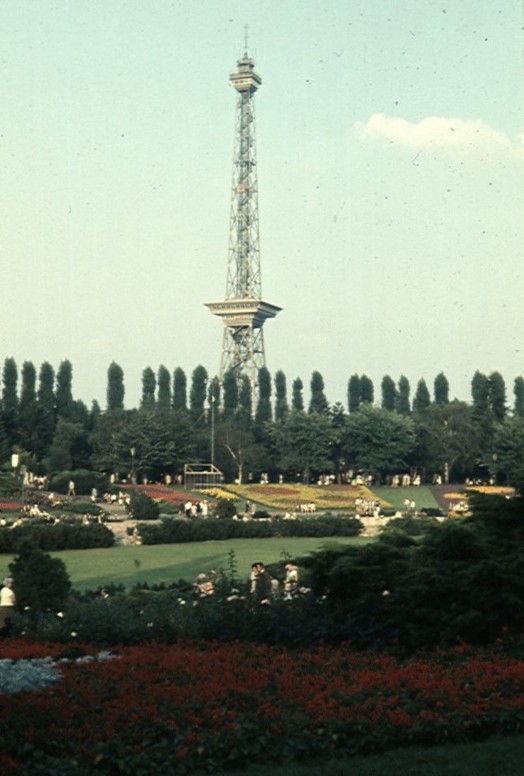 |
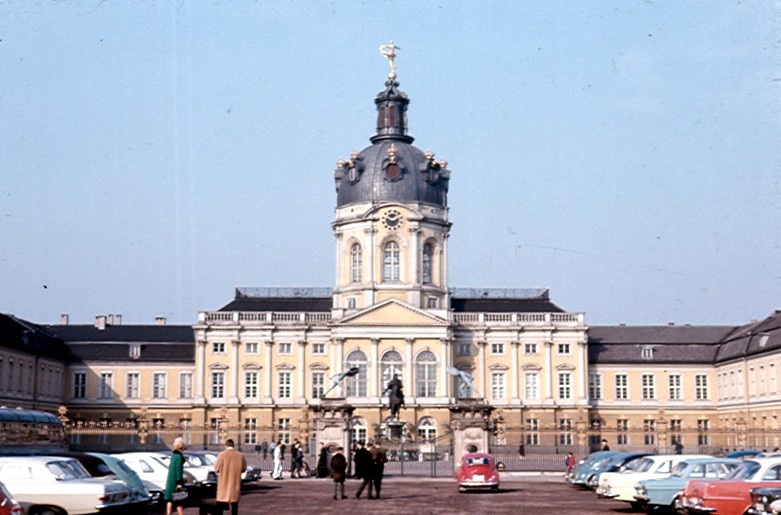
▲ Schloss
Charlottenburg
Surrounded by gardens, the Baroque /
Neo-Classical splendor that is Charlottenburg Palace is nowadays
one of West Berlin's major art museums.
|
|
| Wilmersdorf |
▼
Teufelsberg
Berlin lies in a broad river valley, and is
for the most part fairly flat. One of the few hills of any
consequence stands, quite curiously, in the middle of Grunewald
forest. Dubbed "Teufelsberg" (Devil's Mountain), it is
entirely man-made from wartime rubble, trucked from all over the
city and bulldozed into a huge heap. And by "huge," I mean
something big enough on which to build a modest ski slope!
|
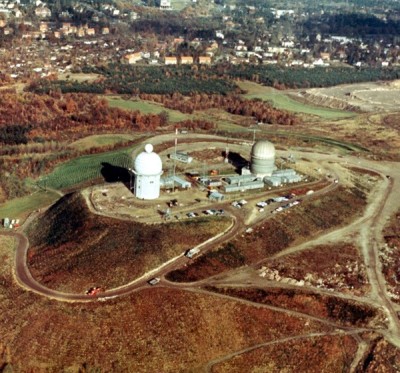
Photo by Andy Fraser, courtesy USASA FSB Reunion
|
At
its summit, T-Berg has one other feature of note: the
military installation where I worked. The compound is
surrounded by a high double fence adorned with signs listing the
grave penalties for photographing the place. However, I
was recently lucky enough to acquire an aerial photo—evidently
taken by someone not near enough to read the signs. Even
this partial shot of T-Berg, casting its shadow upon the
landscape below, manages to capture something of its enormity.
If you're interested in such things,
click here for a somewhat more
detailed peek at this installation.
|
It has recently been rumored that, since the demise of
what one of our former leaders termed the "Evil Empire," the
military functions of the Teufelsberg site are no longer
necessary, and there are plans to turn the place into a
restaurant. The food must have improved quite a bit since
I worked there!
|
Grunewald Turm
►
This tower is spotted on a low hill (Karlsberg)
along the eastern bank of the Havel River. I've been told
by a Berlin news commentator that it was built as a memorial to
Kaiser Wilhelm II. (Thus it is also known as
Kaiser-Wilhelm Turm—not to be confused with the famous church
downtown, pictured a few frames above, near the end of the "Tiergarten"
grouping.)
The tower is a bit out of the way for a vanity
structure, however, prompting speculation about whether it might
also have served some practical purpose, such as a beacon for
river navigation or a fire-watch facility for the surrounding Grunewald forest. It currently plays the role of a vantage
point for any sightseers hardy enough to climb its stairs.
|
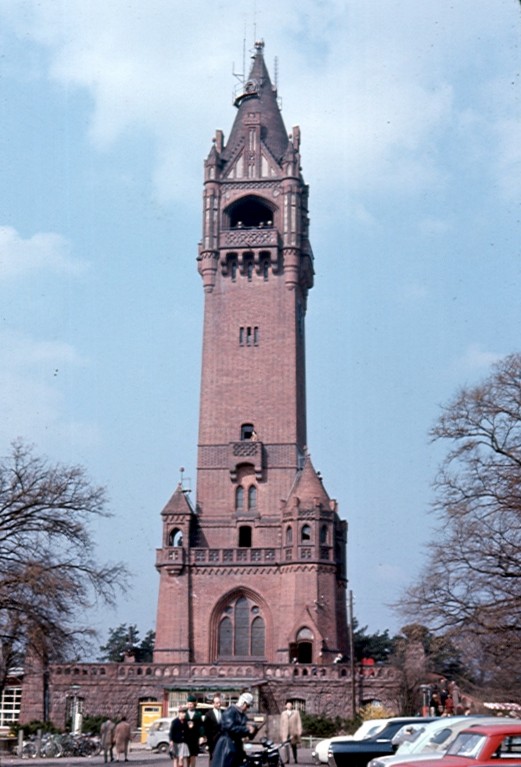 |
|
|
|
|
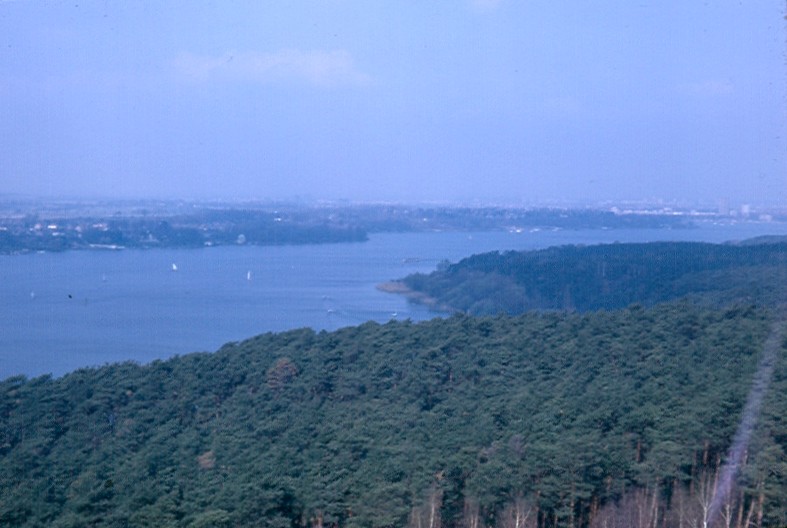 |
◄
Grunewald
What was left of Berlin's western forest after
World War II was ravaged by Berliners in desperate need of
firewood. It was subsequently restored by the occupying
powers, in typical military fashion—all the trees lined up in
neat rows and columns. Strolling through, one almost
expects to hear them marching, like the ents from Tolkien's
Lord of the Rings...
Here we see a small slice of the restored
forest, looking northward from Grunewald Turm along the Havel
River.
|
|
| Spandau |
|
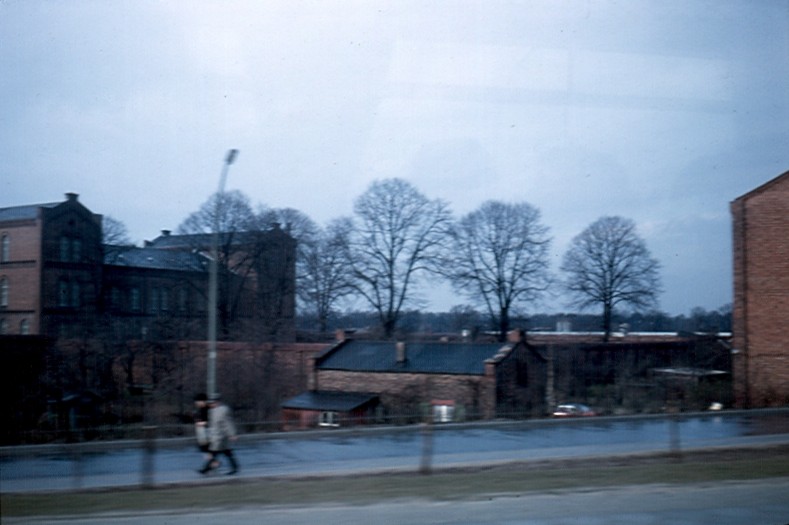 |
◄ Spandauer Gefängnis
In the 1960s, Spandau Prison has only one
inmate: Rudolf Hess, once Adolf Hitler's Vice Chancellor.
|
|